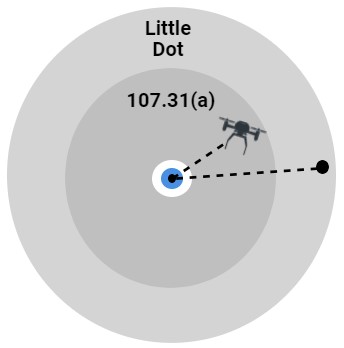- Joined
- Dec 31, 2018
- Messages
- 24
- Reactions
- 5
Any flying, 107 or recreational, requires you to maintain eye contact with your drone... VLOSI recently received my part 107, my understanding is when you fly you must remain in eye contact while flying. If you are wearing the goggles you are flying by the camera ? Also what is to prevent a bird attack?
It looks fun to fly, just want to be legal
Thanks
Marty
That's not true -- at least in the US. You can fly with a VO.Any flying, 107 or recreational, requires you to maintain eye contact with your drone... VLOS
Agree with you..... as long as you have verbal non electronic communicationThat's not true -- at least in the US. You can fly with a VO.
Agree with you..... as long as you have verbal non electronic communication
With your VO.
I stand corrected... but caution against flying while trying to use a radio setup unless a large amount of $ is invested in same.The method of communication is not prescribed in 107.31 or 107.33. 107.33 simply requires "effective communication with each other at all times". It doesn't rule out using radio comms.
In contrast, the recreational exception 49 U.S.C §44809 requires "direct communication" with a co-located VO, which presumably makes radio communication pointless.
For reference, the rules that cover this issue for Part 107 flying:
§ 107.31 Visual line of sight aircraft operation.
(a) With vision that is unaided by any device other than corrective lenses, the remote pilot in command, the visual observer (if one is used), and the person manipulating the flight control of the small unmanned aircraft system must be able to see the unmanned aircraft throughout the entire flight in order to:
(1) Know the unmanned aircraft's location;
(2) Determine the unmanned aircraft's attitude, altitude, and direction of flight;
(3) Observe the airspace for other air traffic or hazards; and
(4) Determine that the unmanned aircraft does not endanger the life or property of another.
(b) Throughout the entire flight of the small unmanned aircraft, the ability described in paragraph (a) of this section must be exercised by either:
(1) The remote pilot in command and the person manipulating the flight controls of the small unmanned aircraft system; or
(2) A visual observer.
Notice that paragraph (a) says that the PIC, person manipulating controls, AND visual observer (if used) must all be able to see the the drone for the entire flight. But then paragraph (b) turns around and says that the ability to see the drone must be maintained by either the PIC and person manipulating controls, OR by a visual observer.
I suspect that they wouldn't have added paragraph (b) if they hadn't intended it to be legal to operate with a visual observer watching the drone while the pilot in command has his head down or in goggles the entire flight. But if you look at paragraph (a) in isolation, it looks like the PIC must always be able to see the drone.
No, it’s not. It says that the PIC must be able to see the drone “throughout the entire flight” which isn’t possible whenever goggles are being worn.

I haven't misunderstood the statement - it's badly written. It says:No, you have misunderstood 107.31 (a). The statement that the RPIC must be able to see it doesn't mean that the RPIC must be looking at it, provided there is a VO who is looking at it. That situation includes the RPIC looking at a controller, and it also includes wearing goggles, as long as they can be removed if needed to look at the aircraft.
.........
So at any one time, at least one of them must be looking at the drone.
No, you have misunderstood 107.31 (a). The statement that the RPIC must be able to see it doesn't mean that the RPIC must be looking at it, provided there is a VO who is looking at it. That situation includes the RPIC looking at a controller, and it also includes wearing goggles, as long as they can be removed if needed to look at the aircraft.
...........
I’m not disputing any of that. I was simply pointing out that whilst that’s what the official statement means, its not what it says. Including the word “and” in it means that everyone has to see it the drone continuously.@sar104 is 100% correct and even provides official documentation to back it up.
If the VO has "Eyes On" the aircraft the RPIC is allowed to NOT be actually looking AT the aircraft at all times but must be ABLE TO if needed.
I’m not disputing any of that. I was simply pointing out that whilst that’s what the official statement means, its not what it says. Including the word “and” in it means that everyone has to see it the drone continuously.
Thank YOU for taking the time to add valuable information to the debate.Bless all you legal scholars!
We use essential cookies to make this site work, and optional cookies to enhance your experience.


